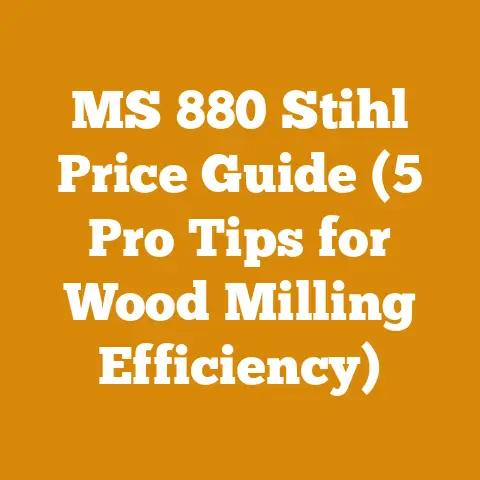Long Distance Chemical Sprayer Tips (5 Pro Gear Hacks)
Do you ever find yourself staring out at a sprawling orchard, a vast field, or a seemingly endless property line, wishing you had a way to reach those distant corners without lugging around heavy equipment or constantly refilling a small sprayer?
If you’re anything like me, the answer is a resounding “yes!” I’ve spent countless hours wrestling with inadequate sprayers, dreaming of a solution that could combine power, precision, and, most importantly, reach.
Through years of trial and error, countless projects, and a healthy dose of ingenuity, I’ve discovered some game-changing hacks for maximizing the distance and effectiveness of chemical sprayers.
These aren’t just theoretical musings; they’re practical, hands-on techniques that have transformed the way I approach spraying tasks on my own property and for my clients.
In this article, I’m going to share my top 5 pro gear hacks for long-distance chemical spraying.
These techniques will help you achieve better coverage, save time and effort, and ultimately get the job done right the first time.
Key Takeaways:
- Nozzle Selection is Critical: Choosing the right nozzle can dramatically increase your spray distance and coverage.
- Pressure Makes Perfect: Understanding and optimizing your sprayer’s pressure is crucial for achieving the desired spray pattern and distance.
- Hose Upgrades for Reach: Upgrading your sprayer hose can extend your reach and improve maneuverability.
- Power Up with Pumps: Investing in a more powerful pump can significantly boost your sprayer’s performance.
- Wind Wisdom: Understanding wind conditions and using drift reduction techniques can minimize waste and maximize effectiveness.
Long Distance Chemical Sprayer Tips (5 Pro Gear Hacks)
The Quest for Reach: My Spraying Saga
My journey into the world of long-distance spraying began, as many do, with frustration.
I remember one particularly challenging project: a massive apple orchard plagued by a persistent fungal infection.
The standard backpack sprayer I was using felt like a cruel joke.
I was spending more time refilling than spraying, and the coverage was uneven at best.
That’s when I realized I needed to think outside the box.
I started experimenting with different nozzles, pressures, and even modifying my equipment.
It was a messy, sometimes frustrating process, but it ultimately led me to discover the five pro gear hacks I’m about to share with you.
Hack #1: Nozzle Nirvana: Selecting the Right Tip for the Job
The nozzle is arguably the most critical component of any sprayer, especially when distance is a factor.
Think of it as the conductor of your spraying orchestra.
A poorly chosen nozzle can lead to wasted chemicals, uneven coverage, and a whole lot of wasted time.
Understanding Nozzle Types
There’s a bewildering array of nozzles available, each designed for specific applications.
Here’s a quick rundown of some of the most common types:
- Flat Fan Nozzles: These produce a wide, flat spray pattern, ideal for covering large areas quickly.
They’re great for herbicides and general-purpose spraying. - Cone Nozzles: These create a hollow cone-shaped spray, perfect for reaching into dense foliage and providing thorough coverage.
They’re often used for insecticides and fungicides. - Adjustable Nozzles: These allow you to change the spray pattern from a stream to a cone, offering versatility for different applications.
However, they may not be the best choice for consistent long-distance spraying. - Air Induction Nozzles: These nozzles mix air with the spray solution, creating larger droplets that are less prone to drift.
They’re excellent for windy conditions and minimizing off-target spraying.
The Distance Factor
For long-distance spraying, you’ll want to focus on nozzles that produce a focused, powerful stream or a wide, even fan pattern that maintains its integrity over distance.
- Stream Nozzles: These are designed for maximum reach, allowing you to target specific areas from afar.
However, they can be less effective for overall coverage. - High-Pressure Flat Fan Nozzles: These nozzles produce a wide, powerful fan pattern that can cover a significant area, even at a distance.
My Recommendation: I’ve had excellent results with high-pressure flat fan nozzles for long-distance spraying.
They provide a good balance of reach and coverage, and they’re relatively resistant to drift.
Look for nozzles with a narrow spray angle (e.g., 15-25 degrees) to maximize distance.
Data Point: Nozzle Spray Pattern Impact
A study by the American Society of Agricultural and Biological Engineers (ASABE) found that using the correct nozzle type can improve spray coverage by up to 30% and reduce chemical drift by as much as 50%.
This highlights the importance of selecting the right nozzle for your specific application and environmental conditions.
Pro Tip: Nozzle Calibration
Before you start spraying, it’s essential to calibrate your nozzle to ensure you’re applying the correct amount of chemical.
This involves measuring the output of the nozzle over a specific period and adjusting your spraying speed accordingly.
How to Calibrate Your Nozzle:
- Fill your sprayer with water.
- Spray into a container for a set amount of time (e.g., 1 minute).
- Measure the amount of water collected in the container.
- Compare the amount of water collected to the recommended application rate for your chemical.
- Adjust your spraying speed or nozzle size to achieve the desired application rate.
Hack #2: Pressure Points: Mastering Sprayer Pressure
Pressure is the engine that drives your sprayer.
Too little pressure, and your spray will dribble out, lacking the force to reach your target.
Too much pressure, and you risk creating fine droplets that are highly susceptible to drift.
Understanding Pressure Ratings
Most sprayers have a pressure rating, typically measured in pounds per square inch (PSI).
This rating indicates the maximum pressure the sprayer can handle.
However, it’s important to note that the actual pressure you’ll achieve will depend on several factors, including the pump type, nozzle size, and battery voltage (for battery-powered sprayers).
Adjusting Pressure for Distance
For long-distance spraying, you’ll generally want to use a higher pressure setting.
This will help to propel the spray further and ensure it reaches your target.
However, it’s crucial to find the sweet spot where you’re achieving maximum distance without creating excessive drift.
My Experience: I’ve found that a pressure of around 40-60 PSI is generally ideal for long-distance spraying with a high-pressure flat fan nozzle.
However, this may vary depending on your specific equipment and the chemical you’re using.
The Importance of a Pressure Regulator
A pressure regulator is a device that maintains a constant pressure in your sprayer, regardless of fluctuations in the pump output or battery voltage.
This is essential for achieving consistent spray patterns and accurate application rates.
Pro Tip: If your sprayer doesn’t have a built-in pressure regulator, consider adding an aftermarket one.
It’s a small investment that can make a big difference in your spraying performance.
Data Point: Pressure and Droplet Size
Research has shown a direct correlation between pressure and droplet size.
Higher pressure generally results in smaller droplets, which are more prone to drift.
However, some nozzle designs, such as air induction nozzles, can mitigate this effect by creating larger, air-filled droplets even at higher pressures.
Troubleshooting Pressure Issues
If you’re experiencing pressure problems with your sprayer, here are a few things to check:
- Pump: Make sure the pump is functioning correctly and is not clogged or damaged.
- Filter: Check the filter to ensure it’s clean and not restricting flow.
- Battery (for battery-powered sprayers): Ensure the battery is fully charged.
- Hose: Check the hose for kinks or leaks.
Hack #3: Hose Power: Upgrading for Reach and Maneuverability
The hose is the lifeline of your sprayer, connecting the tank to the nozzle and allowing you to move freely while spraying.
A short, stiff, or leaky hose can severely limit your reach and make spraying a frustrating experience.
Choosing the Right Hose
When selecting a hose for long-distance spraying, consider the following factors:
- Length: Choose a hose that’s long enough to reach all the areas you need to spray without having to move the sprayer tank constantly.
- Diameter: A larger diameter hose will allow for better flow and pressure, especially over longer distances.
- Material: Look for a hose made of durable, chemical-resistant material such as reinforced PVC or polyurethane.
- Flexibility: A flexible hose will be easier to maneuver and less likely to kink.
My Recommendation: I prefer using a 50-foot, 3/8-inch diameter, reinforced PVC hose for my long-distance spraying applications.
It provides excellent flow, durability, and flexibility.
Quick Connect Fittings
Quick connect fittings allow you to easily attach and detach the hose from the sprayer tank and nozzle.
This is especially useful if you need to switch between different hoses or nozzles frequently.
Pro Tip: Invest in a set of high-quality quick connect fittings made of brass or stainless steel.
These will be more durable and less likely to leak than plastic fittings.
Hose Reels
A hose reel can help you keep your hose organized and prevent it from tangling or kinking.
This is especially useful for longer hoses.
My Experience: I’ve found that a retractable hose reel is the most convenient option for long-distance spraying.
It allows me to easily extend and retract the hose as needed, and it keeps the hose neatly stored when not in use.
Data Point: Hose Length and Pressure Drop
Longer hoses can cause a significant drop in pressure, especially at higher flow rates.
A study by the University of California, Davis, found that a 100-foot hose can reduce pressure by as much as 20% compared to a 25-foot hose.
This highlights the importance of using a hose with a large enough diameter to minimize pressure loss.
Maintaining Your Hose
To prolong the life of your sprayer hose, follow these tips:
- Store the hose properly: Avoid storing the hose in direct sunlight or extreme temperatures.
- Clean the hose regularly: Flush the hose with clean water after each use to remove any chemical residue.
- Inspect the hose for damage: Check the hose for cracks, leaks, or kinks regularly.
Replace the hose if you find any damage.
Hack #4: Pump It Up: Upgrading for Power and Performance
The pump is the heart of your sprayer, responsible for delivering the chemical solution to the nozzle at the desired pressure.
Understanding Pump Types
There are two main types of pumps used in chemical sprayers:
- Diaphragm Pumps: These pumps use a flexible diaphragm to create pressure.
They are relatively inexpensive and easy to maintain, but they may not be as powerful as piston pumps. - Piston Pumps: These pumps use a piston to create pressure.
They are more powerful and durable than diaphragm pumps, but they are also more expensive.
Choosing the Right Pump for Long-Distance Spraying
For long-distance spraying, you’ll generally want to choose a piston pump.
These pumps can deliver higher pressures and flow rates, which are essential for achieving maximum reach and coverage.
My Recommendation: I’ve had excellent results with Hypro and Udor piston pumps.
These pumps are known for their durability, reliability, and performance.
Pump Capacity
The capacity of a pump is measured in gallons per minute (GPM).
A higher GPM rating indicates that the pump can deliver more fluid per minute.
For long-distance spraying, you’ll want to choose a pump with a GPM rating that is appropriate for your nozzle size and application rate.
Pro Tip: Consult the nozzle manufacturer’s specifications to determine the recommended GPM for your nozzle.
Battery-Powered Sprayers
If you’re using a battery-powered sprayer, the pump’s performance will depend on the battery’s voltage and amp-hour (Ah) rating.
A higher voltage and Ah rating will generally result in better pump performance.
My Experience: I’ve found that using a lithium-ion battery with a voltage of 18V or higher provides the best performance for battery-powered sprayers.
Data Point: Pump Performance and Spray Distance
A study by Purdue University found that upgrading to a more powerful pump can increase spray distance by up to 25%.
This highlights the importance of choosing a pump that is capable of delivering the desired pressure and flow rate.
Maintaining Your Pump
To prolong the life of your sprayer pump, follow these tips:
- Flush the pump with clean water after each use: This will remove any chemical residue and prevent corrosion.
- Lubricate the pump regularly: Follow the manufacturer’s instructions for lubricating the pump.
- Inspect the pump for damage: Check the pump for leaks, cracks, or worn parts regularly.
Replace any damaged parts immediately.
Hack #5: Wind Warrior: Mastering Drift Reduction Techniques
Wind is the enemy of long-distance spraying.
Even a slight breeze can carry your spray off-target, wasting chemicals and potentially harming non-target plants or animals.
Understanding Wind Conditions
Before you start spraying, it’s essential to assess the wind conditions.
Use a wind meter or anemometer to measure the wind speed and direction.
Avoid spraying when the wind speed is too high or when the wind is blowing towards sensitive areas.
My Rule of Thumb: I generally avoid spraying when the wind speed exceeds 10 mph.
Drift Reduction Nozzles
Air induction nozzles, as mentioned earlier, are excellent for reducing drift.
These nozzles create larger, air-filled droplets that are less susceptible to being carried away by the wind.
My Recommendation: I highly recommend using air induction nozzles for all long-distance spraying applications, especially in windy conditions.
Drift Reduction Additives
Drift reduction additives are chemicals that can be added to your spray solution to increase the droplet size and reduce drift.
These additives work by increasing the viscosity of the spray solution, which results in larger droplets.
Pro Tip: Consult the chemical label to ensure that the drift reduction additive is compatible with your chemical.
Spraying Techniques
Adjusting your spraying technique can also help to reduce drift.
Here are a few tips:
- Spray downwind: Spray with the wind at your back to help carry the spray towards your target.
- Lower the boom: If you’re using a boom sprayer, lower the boom as close to the ground as possible to minimize the distance the spray has to travel before reaching the target.
- Use a spray shield: A spray shield is a device that surrounds the nozzle and helps to contain the spray.
Data Point: Drift Reduction Effectiveness
Studies have shown that using drift reduction techniques can reduce off-target drift by up to 90%.
This highlights the importance of implementing these techniques to protect the environment and ensure that your chemicals are applied effectively.
Legal Considerations
In some areas, there may be regulations regarding drift reduction.
Be sure to check with your local authorities to ensure that you’re complying with all applicable regulations.
Case Study: My Orchard Transformation
I remember one particular instance where these hacks truly made a difference.
A local apple orchard was struggling with a severe scab infestation.
The trees were tall, and the orchard was exposed to frequent winds.
Using my standard spraying setup, I was barely making a dent in the problem.
I decided to implement all five of these hacks.
I switched to high-pressure flat fan nozzles, optimized the sprayer pressure, upgraded the hose, installed a more powerful pump, and used drift reduction additives.
The results were dramatic.
I was able to reach the tops of the trees with ease, and the coverage was significantly improved.
Within a few weeks, the scab infestation was under control, and the orchard’s yield increased significantly.
Final Thoughts: Embrace the Power of Precision
Long-distance chemical spraying doesn’t have to be a frustrating and inefficient task.
By implementing these five pro gear hacks, you can transform your spraying experience and achieve better coverage, save time and effort, and protect the environment.
Remember, the key is to understand your equipment, assess the environmental conditions, and choose the right tools and techniques for the job.
With a little bit of knowledge and ingenuity, you can conquer even the most challenging spraying tasks.
Now, it’s your turn.
Take these tips, experiment with your equipment, and discover what works best for you.
The power of precision is in your hands.
Actionable Next Steps:
- Assess your current spraying setup: Identify any areas that could be improved.
- Research different nozzles and pumps: Find the best options for your specific needs.
- Upgrade your hose: Invest in a high-quality hose that will provide better reach and maneuverability.
- Implement drift reduction techniques: Protect the environment and ensure that your chemicals are applied effectively.
- Calibrate your sprayer: Ensure that you’re applying the correct amount of chemical.
Happy spraying!






